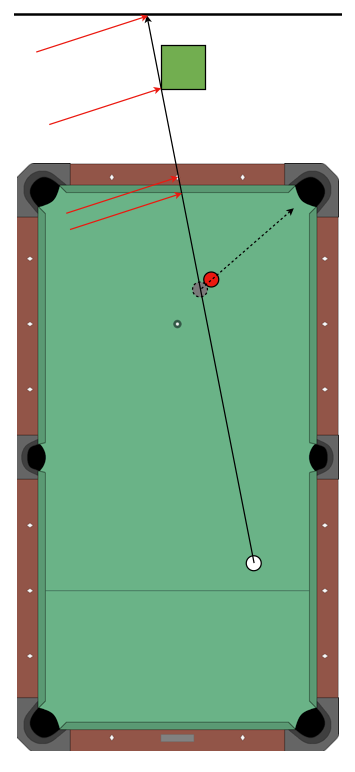A lot of players aim by feel, or use “ghost-ball” aiming. Although this can work great, some shots are hard to see, and some nights you just can’t see shots as well as others. You have to blend a little bit of imagination and feel into your aim to find that line. The longer the shot and thinner the cut, the harder it is to see.
Spot aiming is a mechanical procedure to take the guess-work out of your aiming alignment. This system will ensure you have an exact line of aim for center pocket.
NOTE: As with any aiming system we have to account for english and Contact-Induced-Throw. We’ll address that in a moment.
Let’s look at a typical cut shot.
Here we have a cut-shot to the right into the corner pocket. The white ball is the cue ball, the red ball is the object ball, and the grey ball is the ghost ball.
To use spot aiming, first find your aim line through the ghost ball. One method is to line up your cue stick directly in line with the object ball and the target pocket. Drop the cue tip on the table exactly where the ghost ball would be resting, which is slightly more than an inch behind the object ball (1.25″). Now, rotate the cue stick until you are directly over the cue ball. You are now on the aim line.
Look down the aim line and pick a spot directly on this line. The red arrows indicate examples of spots you might use. For short shots, you might find a piece of lint or chalk mark on the rail, or maybe the edge of a diamond lines up. For longer shots you might use the edge of a table or chair, or maybe a poster on the wall has something you can train your eye on.
When you execute your shot, look at this spot, not the object ball. Aim carefully at center cue ball, and hit the shot firm. The object ball should drop very close to center pocket.
I say shoot the shot firm because all cut shots have some amount of contact-induced-throw (CIT), and a firm hit minimizes this effect. But, it is not always desired to hit the shot firm, so we need to compensated for CIT by either adding a touch of outside english to your shot, or moving the line of aim very slightly away from the object ball. Which you prefer will depend on where you want the cue ball to go. Here are the main factors behind CIT:
- slower cue ball speed adds to the effect of CIT.
- a 1/2 ball hit, or 30 degree angle has the highest amount of CIT. Very thick or very thin shots have almost no CIT.
- when the cue ball and object ball are close together, this adds to the effect of CIT.
In all cases, the more CIT, the more you have to compensate with english or alignment adjustment. This will come with practice, but a good place to start is with a small amount of outside english.
You may also want to blend in some english for your cueball position, in which case you need to be aware of how this affects your shot. Just remember that pockets are wider than the balls so when you start with center-pocket alignment, this gives you the maximum wiggle room for the influence of english on your shot.
Spot Aiming takes the guess work out of center-pocket aiming for any and all shots. It is simple to use and requires no learning curves. Although it may not be practical or for the simplest of shots, it is a great helper for longer shots and thin cuts.

